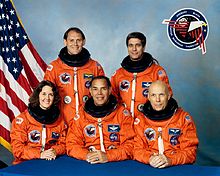 Discovery in orbit; in-flight photography on this Department of Defense (DoD) support mission is limited. | |
| Names | Space Transportation System-33 STS-33R |
|---|---|
| Mission type | DoD satellite deployment |
| Operator | NASA |
| COSPAR ID | 1989-090A |
| SATCAT no. | 20329 |
| Mission duration | 5 days, 6 minutes, 48 seconds |
| Distance travelled | 3,400,000 km (2,100,000 mi) |
| Orbits completed | 79 |
| Spacecraft properties | |
| Spacecraft | Space Shuttle Discovery |
| Landing mass | 88,125 kg (194,282 lb) |
| Payload mass | 21,000 kg (46,000 lb) |
| Crew | |
| Crew size | 5 |
| Members | |
| Start of mission | |
| Launch date | November 23, 1989, 00:23:30 UTC (7:23 pm EST) |
| Launch site | Kennedy, LC-39B |
| Contractor | Rockwell International |
| End of mission | |
| Landing date | November 28, 1989, 00:30:18 UTC (4:30:18 pm PDT) |
| Landing site | Edwards, Runway 4 |
| Orbital parameters | |
| Reference system | Geocentric orbit |
| Regime | Low Earth orbit |
| Perigee altitude | 519 km (322 mi) |
| Apogee altitude | 519 km (322 mi) |
| Inclination | 28.45° |
| Period | 88.70 minutes |
| Instruments | |
| |
 STS-33 mission patch  Back row: Carter and Blaha Front row: Thornton, Gregory and Musgrave | |
STS-33 was a NASA Space Shuttle mission and the 9th flight of Discovery, during which Space Shuttle Discovery deployed a payload for the United States Department of Defense (DoD). It was the 32nd shuttle mission overall, the ninth flight of Discovery, the fifth shuttle mission in support of the DoD, the seventh post-Space Shuttle Challenger disaster mission and the last Shuttle mission of the 1980s. Due to the nature of the mission, specific details remain classified. Discovery lifted off from Launch Complex 39B at Kennedy Space Center (KSC), Florida, on November 22, 1989, at 7:23:30 p.m. EST; it landed at Edwards Air Force Base, California, on November 27, 1989, at 7:30:16 p.m. EST.
The mission was officially designated STS-33R as the original STS-33 designator belonged to the ill-fated Challenger STS-51-L, the 25th Space Shuttle mission. Official documentation for that mission contained the designator STS-33 throughout. As STS-51-L was designated STS-33, future flights with the STS-26 through STS-33 designators would require the R in their documentation to avoid conflicts in tracking data from one mission to another.